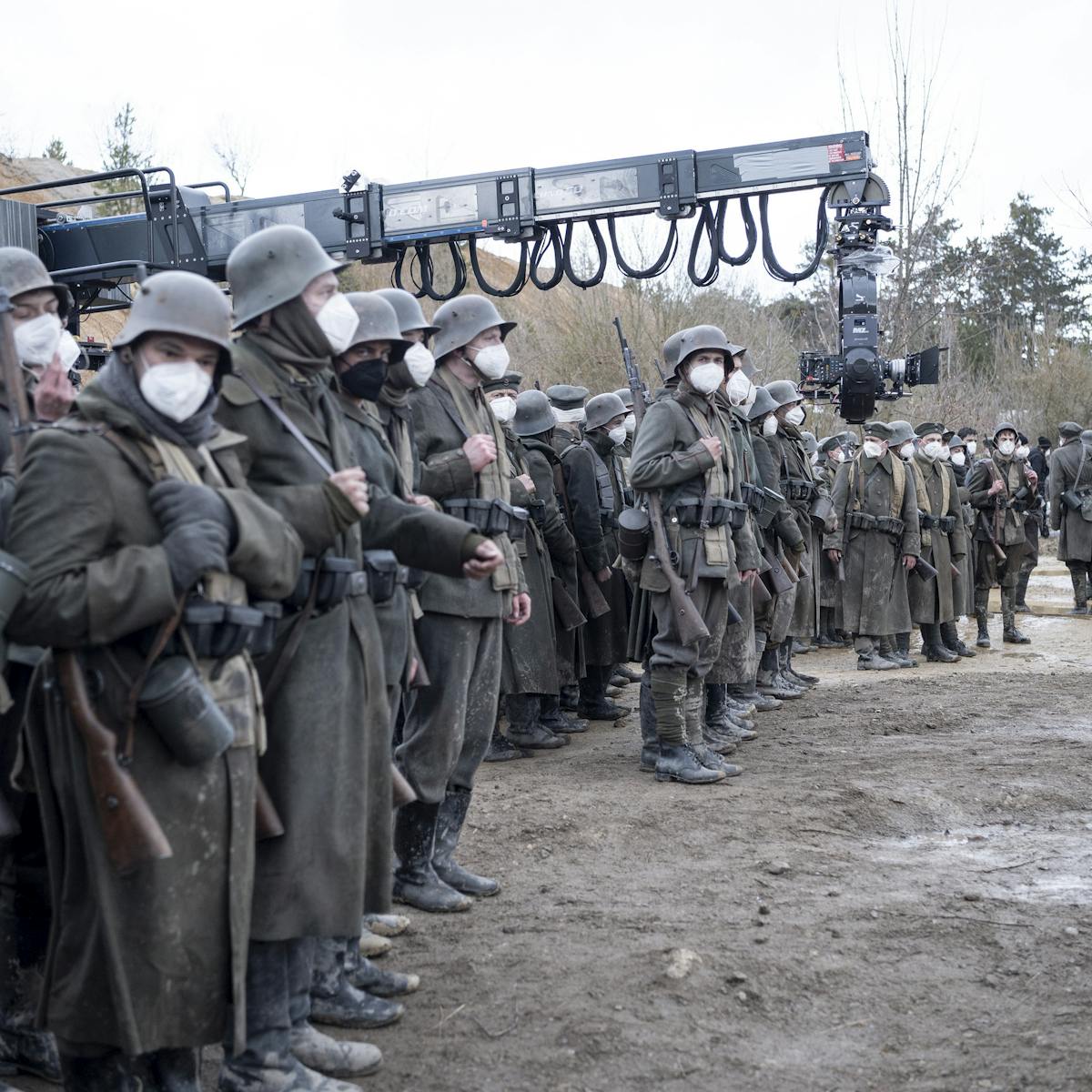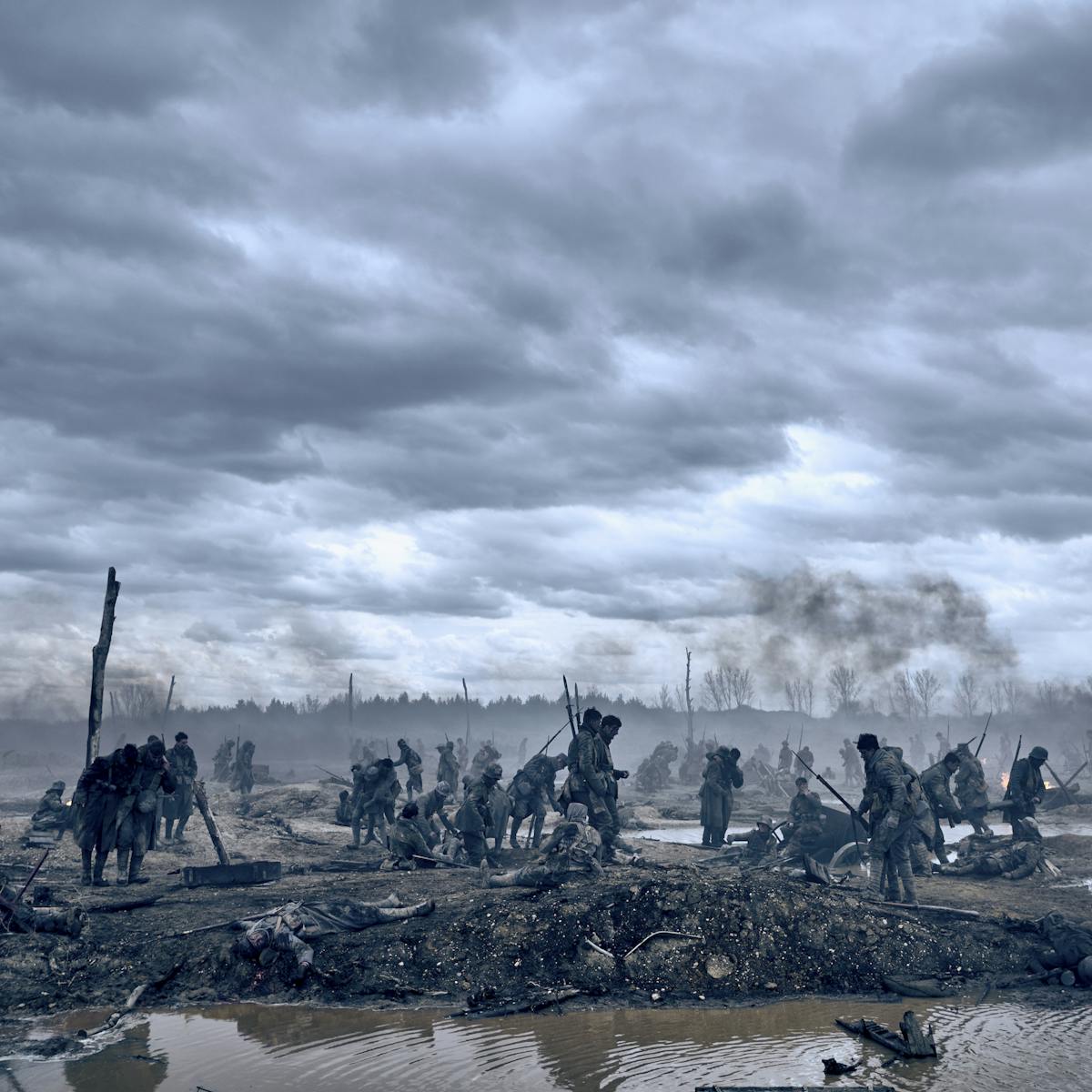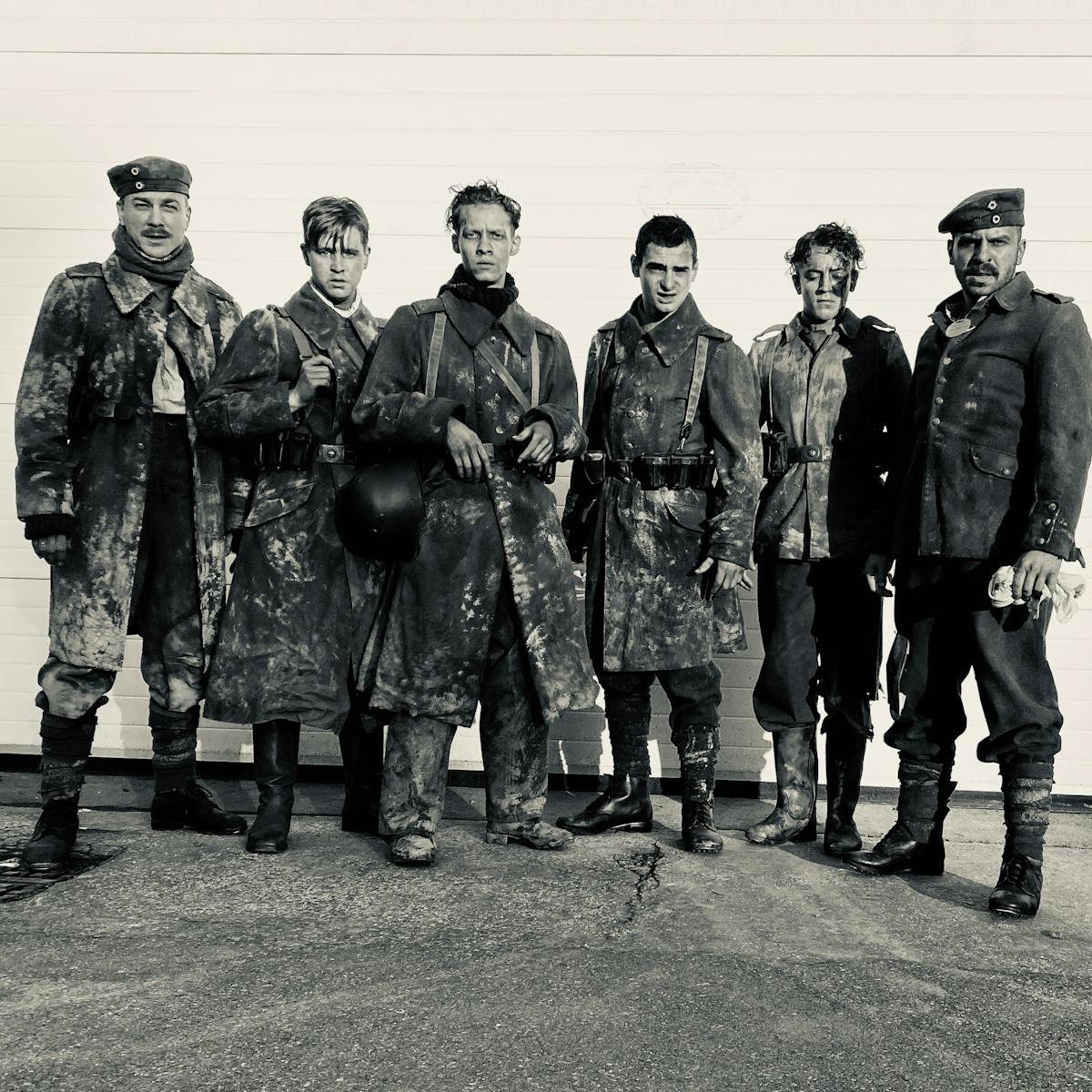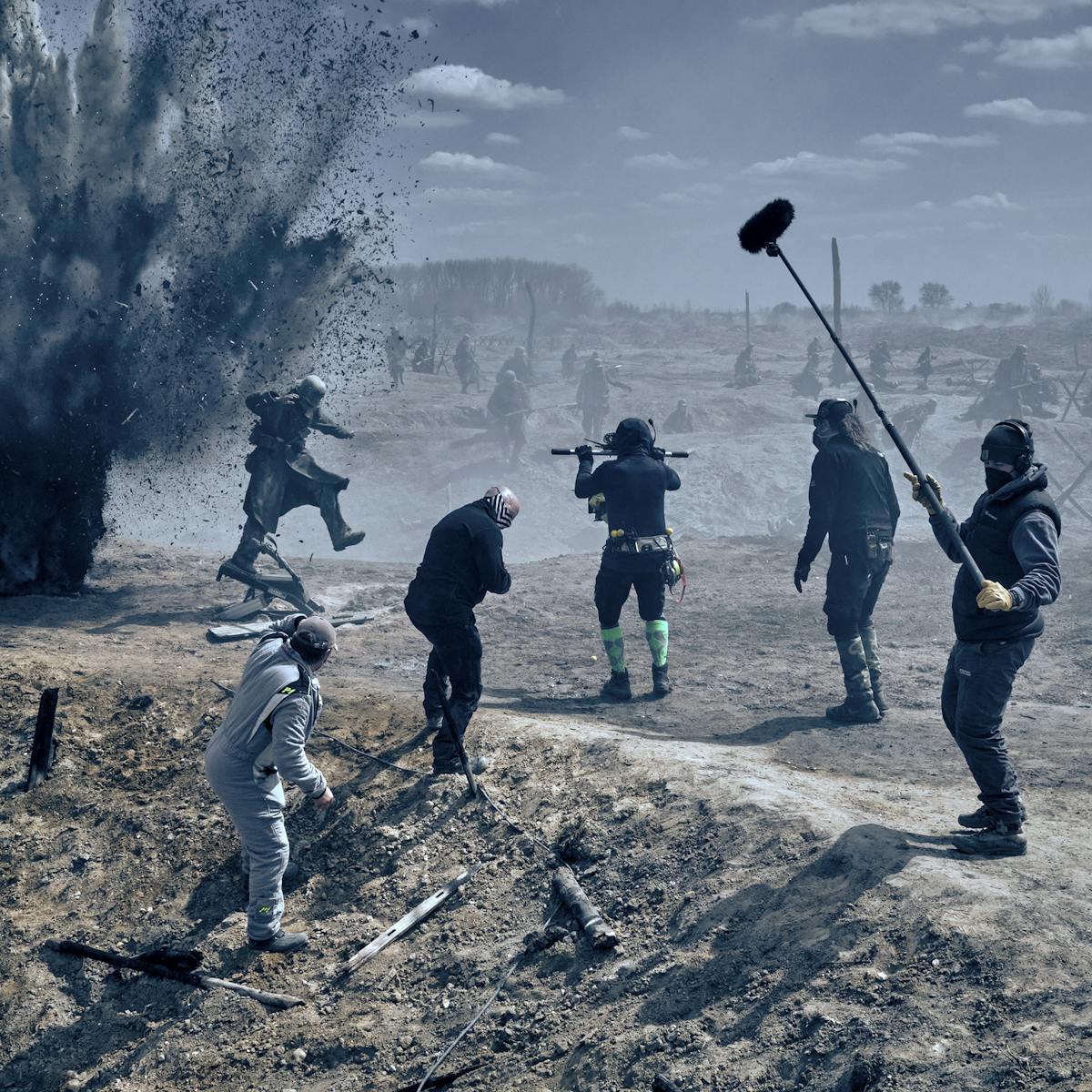All Quiet on the Western Front reminds us of the follies of war.
War stories most often center on heroes, those who endure incalculable hardships on the battlefield but emerge victorious, having saved their countries from imminent danger. But in writing his 1929 World War I novel All Quiet on the Western Front, German author Erich Maria Remarque wanted to emphasize not the one-in-a-million soldier who escapes war unscathed, but the thousands for whom war is a disaster — in the hopes of avoiding future conflict.
The tale couldn’t have been timelier. By 1930, when Lewis Milestone’s American film adaptation of the novel was released in Berlin, the Nazi Party had already risen to power. They banned the movie as anti-German, but later that year, it took home the Oscar for Outstanding Production, the equivalent of today’s Best Picture. While Remarque’s novel was lauded around the world, including a nomination for the Nobel Peace Prize in 1931, at home All Quiet and its sequel were both banned and burned by the Nazi Party.
Now, German director Edward Berger has retold the timeless anti-war story once more, helming the first German-language adaptation for twenty-first-century audiences. The highly acclaimed new film follows 17-year-old soldier Paul Bäumer (Felix Kammerer) and his group of friends as they gleefully enlist, and then are transformed by unimaginable atrocities through the end of World War I. Beautifully crafted and thoroughly affecting, Berger’s All Quiet on the Western Front again serves as a powerful reminder of the perils of war. The film has now been nominated for an impressive nine Academy Awards, in the categories of Best Picture, Best International Feature Film, Best Adapted Screenplay, Best Cinematography, Best Sound, Best Production Design, Best Visual Effects, Best Makeup and Hairstyling, and Best Original Score.
Paul Bäumer (Felix Kammerer), Albert Kropp (Aaron Hilmer), Franz Müller (Moritz Klaus), Tjaden Stackfleet (Edin Hasanovic), and Ludwig Behm (Adrian Grünewald)
A German Perspective
“In most cases, American or British war movies cannot help but find a positive side in their stories. Traveling on the tube in London in November, I see people wearing poppies in remembrance of the ceasefire. The soldiers returned home after the war and were celebrated as heroes in Trafalgar Square. We’re familiar with similar images from America, in Times Square where people fell into each other’s arms. America was dragged into the war against its will and freed Europe from Fascism. That does something to a country’s psyche. War is automatically associated with heroism. Of course, it was also horrifying and resulted in terrible losses for these countries, no doubt. But it was an experience with a successful outcome, and these days, when an American or British director portrays war in a movie, this feeling sort of permeates on its own accord. Contrary to this, it was important to me to take on the German perspective. It’s a perspective which no longer exists in modern war movies because we usually lack the courage and the opportunities to show it.”
— Edward Berger, director, co-writer, and producer of All Quiet on the Western Front
“Our view of war is marked by grief and shame, sorrow and death, destruction and guilt. There is nothing positive or heroic. Every death, regardless of which side, is a death and is therefore simply horrific; it’s a person who died. I felt that making our history, background, and attitude toward war the driving force behind the movie was a huge and fascinating challenge. I thought it might be interesting to share this perspective from Germany with the world.”
— Edward Berger, director, co-writer, and producer of All Quiet on the Western Front
“If you look at Remarque’s story of young high-school students who are enthusiastically drawn to the front in France and are immediately confronted with the horrific reality of war there, then, yes, it’s a story rooted in the First World War, but it could easily be today. Right from the start, it was clear to us that we didn’t want to tell a heroic story. All Quiet on the Western Front is not a tale of heroes, and it can’t be one. Unlike classic war movies, the death of an enemy is not a positive outcome here. It is not a step on the way to achieving a goal. The death of an enemy is another death, the same as the death of a comrade, a friend, or a superior. It was important that the perspectives were completely interchangeable. The horror is the same for all parties involved.”
— Malte Grunert, producer of All Quiet on the Western Front
Paul Bäumer (Felix Kammerer) and a french soldier face off in the mud
Portraying War Authentically
“On the one hand, it was important to me to create a contrast to the hopeless, endless slaughter and, on the other hand, to find a historical framework for our story, which emphasizes the absolute senselessness of the war.”
— Edward Berger, director, co-writer, and producer of All Quiet on the Western Front
“We wanted to be historically authentic at all times. Especially if you decide not to paint your war story as a trial of heroes but rather to actually make a movie about war, authenticity is paramount. Of course, Remarque’s novel is a fictional work with invented characters, but it is written based on his own experience on the Western Front in the First World War. In all areas, from the production design by Christian M. Goldbeck to the costume design by Lisy Christl, from weapons to props, we were always seeking historical advice. Where we show events with real historical figures, they have also been cross-referenced, checked, and portrayed with a view to accuracy. This was never a burden. It was an important guiding principle.”
— Malte Grunert, producer of All Quiet on the Western Front
“It is my absolute conviction that the violence in this movie is not fascinating. It is always repulsive and grisly. If you take this book about war and its descriptions of war seriously, you can’t avoid showing things that move the viewers. I sincerely hope that we have found the right balance to explain what was going on at the time and not to scare away the viewers.”
— Malte Grunert, producer of All Quiet on the Western Front
“Until the start of the shoot, I watched every war movie that I could get my hands on. I read about 15 books on the First World War, war in general, and atrocity across the board. And finally, I collected about 400 photos from the internet and from books. I wanted to be completely oversaturated with information.”
— Felix Kammerer, actor who plays Paul Bäumer
“Of course, we didn’t reconstruct the frontline exactly one-to-one, but instead created the battlefield and the trenches in a way that was ideal for our director of photography James Friend and his team. [Production designer] Christian M. Goldbeck and his team, however, were closely focused on what it really looked like and really felt like. This went so far that we did research as to which regiments actually came from Westphalia and which numbers they wore, because our boys came from Westphalia. We were meticulous. It didn’t necessarily make life easier for us, but it is an important reference. If you decide to do something correctly, there is only one right way.”
— Malte Grunert, producer of All Quiet on the Western Front
“There are so many iconic war movies. If you have a story that unfolds in the trenches and no-man’s-land, there are only so many ways you can do it without it feeling gimmicky or overly forced. And we wanted our film to feel very natural. We wanted the audience to feel like it was with the characters in the trenches.”
— James Friend, cinematographer of All Quiet on the Western Front
“Edward Berger has masterfully succeeded in replicating the fine balance between insidious, anonymous violence and the humanity that characterizes the book.”
— Professor Daniel Schönpflug
Repurposing uniforms
War is War
“World War I is much more what we imagine as a Great War. If you only describe it without clearly assigning it to a date, it remains, very simply, just war — it could be any war. The true quality of the book is that it describes this war very precisely but at the same time remains widely applicable because its story is not strictly tied to a specific location.”
— Felix Kammerer, actor who plays Paul Bäumer
“It was hard to shoot. And it was hard to watch. I think we have succeeded as filmmakers if it is hard to watch. War is horrific. And at the end of the day, it is an anti-war film because it exposes the reality of war and how going in with a naive attitude like those poor kids did, because they are being seduced by their government and their country and their elders. There is a saying from a different film: War is old men talking and young men dying. I remember saying that to Ed. That is something that always resonated with me. The audience should go in very optimistic in the beginning and should come out completely broken.”
— James Friend, cinematographer of All Quiet on the Western Front
“For the first time, industrialization had led to the creation of an automatic weapons industry that not only produced a lot of weapons but also, most importantly, weapons that killed countless people at once. In the Franco-Prussian War of 1870-1871, the military still fought each other with sabers. In archive photos from the First World War, I was confronted with a topographic dystopia filled with empty cartridges and spent grenades. In the Battle of Verdun alone, both sides shot about 50 million tons of bombs and grenades. I felt queasy because I was faced with the task of finding ways and means to represent the incomprehensible scale of this machinery of destruction. To visually present the madness behind it all — that was the biggest challenge for me.”
— Christian M. Goldbeck, production designer of All Quiet on the Western Front
“In our very first conversation, Edward and I noticed that war events in historical movies were always depicted as gruesome, but almost always from the victor’s point of view, resulting in stories about heroes. The novel All Quiet on the Western Front by Erich Maria Remarque is definitely not a story of heroes. Our concern was to represent the steady fall and the ordeal of our protagonist Paul, as immediately as possible, to experience it as closely and realistically as possible without exaggeration. It’s not only about seeing the set, the scene — you should be able to smell it.”
— Christian M. Goldbeck, production designer of All Quiet on the Western Front
“Music always has a particularly difficult time when many frequencies are already covered. Then you have to ask yourself, is that what’s needed at this moment? How should it sound and be in relation to the noises of war? What do you hear in the foreground — the explosion or the music? We tried both and worked with different perspectives. At one moment the music is dominant, you can see the war; the next moment we take the perspective of our protagonist, the noise fades into the background and the music becomes stronger, almost like in a dream. This is very effective, a wonderful narrative element.”
— Volker Bertelmann, composer of All Quiet on the Western Front
“I believe it is important that every generation gets to see a movie format where the war is portrayed in a way that’s current, to bring this new generation eye-to-eye with the topic. I’m not sure whether young people can really relate to Lewis Milestone’s absolutely fantastic version or the version from the 1970s. It is important that viewers feel directly addressed, and we had all the modern options for storytelling in order to make this happen. This was our aim: to bring a frank and unabashed view of war to the screen.”
— Sven Budelmann, editor of All Quiet on the Western Front
“I would always choke up, even while editing the movie, and now when I see the finished movie, it’s even more powerful. I think it’s all about the stoic narrative, the spectacular camera work, and the visual imagery. Everything is shown so objectively, mathematically, that as a viewer, you always get the impression that this is how it is, so you have to show it. And the machine of war plows on . . . ”
— Sven Budelmann, editor of All Quiet on the Western Front
“As a cinematographer and a filmmaker I usually divorce myself from being an audience member. This is one of the first films that I have been involved in where I wasn’t watching where the camera focus was or where the backlight was. I got completely sucked into the incredible performances and the incredible writing and the stunning direction. I would say we achieved what we set out to do.”
— James Friend, cinematographer of All Quiet on the Western Front
“Immediately after the end of the war, Alfred Döblin published his November 1918: A German Revolution; [around the same time] in 1919 Leonhard Frank’s Der Mensch ist gut was published; in 1920 Ernst Jünger publishes Storm of Steel; and Ernst Friedrich’s War Against War came out in 1924. And these are only the best-known German examples amidst a massive wave of global publication. So what distinguishes Remarque’s book? On the one hand, it succeeds in striking a balance between the merciless representation of the physical and emotional devastation suffered by the soldiers and the emphasis on their steadfastness and humanity. Through its characters, Remarque gives a face to the nameless torment of war. On the other hand, Remarque writes in a style that brings the past to life using reporting elements. He possesses the gripping language of the new objectivity and expressionist imagery. With these techniques, he succeeded in touching the nerve of a memory that the Germans had not yet completely dealt with.”
— Professor Daniel Schönpflug
“Edward Berger introduced a level that the book doesn’t possess. It presents the ceasefire negotiations of November 1918 in a railway carriage in the forest near Compiègne. The German negotiator, Matthias Erzberger, meets French Marshal Foch, who dictates the terms of the contract to him. So, we get a bird’s-eye view here, to compliment the worm’s-eye view of the soldiers. This gives the present-day viewer, who is much less familiar with the events of the First World War, historical orientation, and also shows how the fates of thousands of simple soldiers depend on the decisions of leadership in their ivory towers.”
— Professor Daniel Schönpflug



